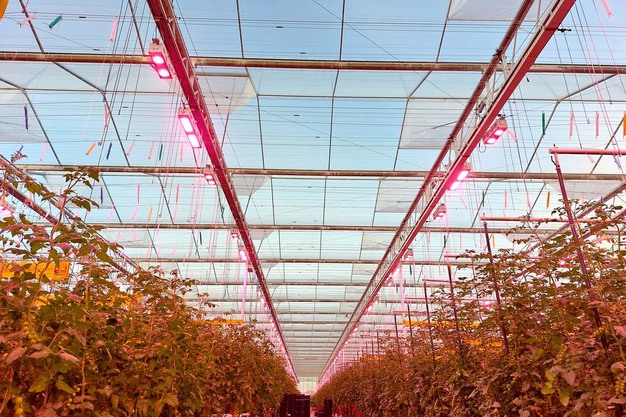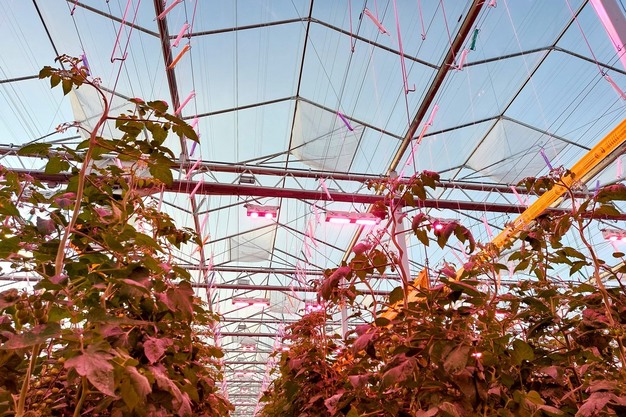 All Gardener's Pride tomato greenhouses in Friesland are now equipped with insect netting by growers' cooperative Oxin Growers. Last winter, grower Marco van Overbeek and his team gained experience in exposed cultivation, and this spring a second greenhouse in Beetgum for the unexposed cultivation was also screened with SchermNed's insect mesh filter.
All Gardener's Pride tomato greenhouses in Friesland are now equipped with insect netting by growers' cooperative Oxin Growers. Last winter, grower Marco van Overbeek and his team gained experience in exposed cultivation, and this spring a second greenhouse in Beetgum for the unexposed cultivation was also screened with SchermNed's insect mesh filter.
Gardener's Pride's tomato greenhouses involve incorporating insect netting into existing greenhouses, with frameless windows in the first 6-hectare greenhouse. "SchermNed's system for application in an existing site was the best fit in terms of maintenance, service, and method of construction."
The insect mesh filter is an alternative to harmonica netting. Harmonic netting is more often used in new-build situations. There are frameless windows in the Friesian greenhouse. For almost two years, there has been the possibility of attaching harmonica netting also to frameless windows via the addition of an aluminum profile. Such an adaptation is not necessary when installing the insect screen. SchermNed supplies both systems.

Greenhouse climate
When it comes to the installation of insect netting, it is also often about the fear of having less good ventilation in summer. "Of course, we don't have that much experience now and, moreover, we haven't had an extreme summer, but we don't have the idea that insect netting has had a negative impact on our greenhouse climate."
Installation took place during cultivation this spring, shares Carl Stougie of SchermNed. "We do that more often. That way there is more time than if it all has to be done during the crop rotation." With the system, a grower still "creates" air, thanks to the shape of the mesh on the inside of the window. "Partly because of this, it remains possible to create good climate. More and more growers in various crops already working with the system have that experience."
"No whitefly and Tuta counted yet"
One adjustment the Frisian tomato growers did make after installing the insect netting: "We keep the windows open at least 2% these days, on both sides. Before, we didn't do that." That way, the tomato growers ensure they keep enough air exchange. "We react a bit earlier with airing since we grow with insect netting," says Marco.
Where Marco notices the biggest effect for now is in pest control. This is also why Oxin Growers installs insect netting in consultation with growers. "I hear from colleagues that you only really start to see the results in the second season that you grow with insect netting. For me, that applies to the exposed crop now. It's been in there for six weeks now, and we still don't count anything at all, no whitefly and no Tuta absoluta either."
At Gardener's Pride, rectangular netting has been installed instead of square netting. Experience and trials with other growers have shown that rectangular netting can stop more pests than square netting. At 90 percent of greenhouse horticulture companies, the choice falls on a mesh size of 0.27x0.77 millimeters, although SchermNed has also seen 0.77 x 0.77 in increasing numbers since last year. At Gardener's Pride, SchermNed installed 0.27x0.77 in the first greenhouse and 0.97x0.604 in the second.

Fewer bumblebee boxes
The grower also notices that fewer bumblebees are needed in his tomato greenhouses. "This is because you not only have less fly-in of pest insects, but also less fly-out of bumblebees. We are putting out fewer bumblebees per hectare these days. We have gone down one bumblebee box per hectare from our standard, and I expect we can go down even further."
Oxin Growers, with the help of SIG&F grants, continuously invests in new techniques at its growers' premises. Customers, in the case of Gardener's Pride including Albert Heijn, are also asking for this. After all, they are increasingly demanding, Marco notes. "Apart from that, I also believe this is the direction we have to go. You have to deal with EU rules and it is well known that fewer and fewer plant protection products are available." Should another new greenhouse be built by the grower in the future, Marco says it will have insect netting in it anyway. "That's not up for discussion."
For more information:
Carl Stougie
Jack van der Voort
SchermNed B.V.
Tel: +31 (0)174 62 22 14
[email protected]
www.schermned.nl
Oxin Growers and Gardener's Pride
[email protected]
www.oxin-growers.nl
